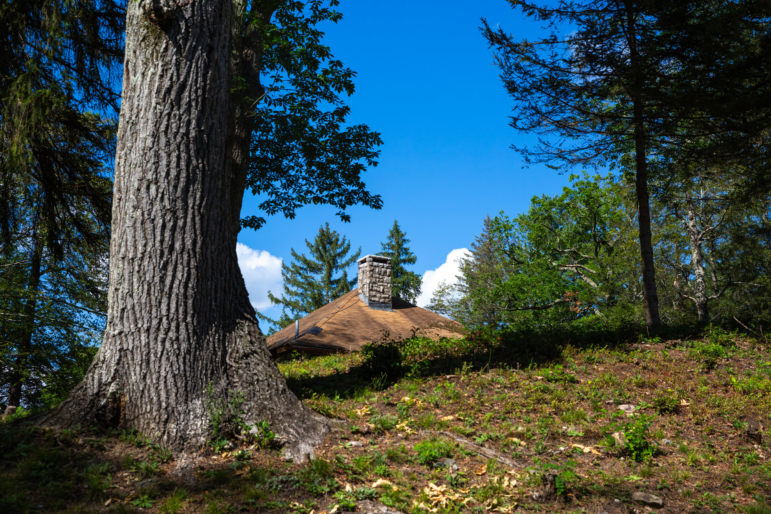About two and a half hours northwest of New York City is Kerhonkson, N.Y., a small hamlet with less than 2,000 people in the Shawangunk Mountains. Woodsy streets lead to the Soyuzivka Ukrainian Heritage Center, a former resort for Ukrainian Americans. Nearby, streets have names like Franko, named after Ivan Franko, a famous Ukrainian poet, and Lisova, which is Ukrainian for “forest.” The entrance to the center is flanked by two giant yellow tryzubs, the Ukrainian trident that is known as a nationalist symbol and often worn as a necklace charm or inked as tattoos.
Busts of Ukrainian historical figures gaze upon park preserves with marked trails, a beautiful outdoor wooden chapel and tennis courts. The image of a Hutsul, an ethnographic group from the Carpathian Mountains, blowing a big horn called a trembita, shows up in a sculpture and within signage. If I wasn’t sure that I was in the right place, cars plastered with Ukrainian flag bumper stickers and a vanity license plate that reads “HOPAK,” Ukraine’s famous folk dance, sealed the deal.
A big ballroom that is nestled under the giant deck made for late night dancing under the stars. The buildings are modeled after the architecture of the Carpathian Mountains, showcasing wood carvings by artist Cherniovsky and named after major Ukrainian cities. Though the accommodations lean more rustic, folks always come back.
“The pool isn’t heated and not everything is super modern, so it has a European feel. It’s cool when I see pictures of my grandparents [with] my parents when they were teenagers… on that balcony. It’s exactly the same. It’s part of the charm,” shared Kalyna Yurchuk, a 20-year-old from West Haven, Conn.
The main house was dark and eerily quiet when I entered. A phone number was left on the front desk to contact with questions, stacks of The Ukrainian Weekly were left for the taking next to the overlooked library, and tacos and Italian night were on the dinner menu. Those who visit Soyuzivka just know where to go and what to do.
This isn’t your baba’s Soyuzivka
Labor Day weekend is the last event of the summer, boasting live bands and plenty of partying. A few hundred Ukrainians from New Jersey, Philadelphia, Chicago and New York socialized at the tiki bar to live acoustic covers of songs by Jack Johnson and Sublime. In between swimming and the competitive volleyball tournament, pockets of friends relaxed while Ukrainian pop music drifted from open balconies during a picture-perfect weekend.
My late father spoke about being a teenage waiter at Soyuzivka during the summers in the late ’50s. He’d come up from Miami to work for room and board with many other Ukrainian immigrants driven out by World War II. Back then, thousands of guests would have to camp out in their cars. The old-timers lament these days of wall-to-wall crowds. Today, the only Ukrainian food being served was varenyky, a potato dumpling, alongside smash burgers and seared ahi tuna at the snack bar.
“We started coming here as teenagers for Labor Day weekend, and it’s just a tradition,” says Mark Temnycky, 32, who’s from New Jersey. “Over the years, [crowds] have dwindled. Because our parents were all immigrants from Ukraine, this was a natural place to congregate. And now, with our generation, people are in college … and everything is competing with Labor Day weekend. But this feels like another home.”
When night fell, the smell of fried food, alcohol and trees mingled with the sounds of crickets and the Canadian rock band, Klooch, warming up for the zabava, or “dance party.” Women teetered on the hilly pavement in heels while many men sported their finest embroidered shirts. Dancing continued into the wee hours, with a promise of a raucous after-party.
From sanitarium to heritage center
The Ukrainian National Association (UNA) is a civic organization in North America that purchased the estate in 1952. Mary Dushnyck writes of the retreat in the group’s 1969 almanac, “Ukrainian children can now spend their vacations in a Ukrainian atmosphere at our bit of Ukraine in the Catskill Mountains of New York — at ‘Soyuzivka,’ the UNA’s pride and joy. Mothers can send their children to the boys’ and girls’ camps, to the Cultural Courses, to compete in sports events or for a vacation. Here an opportunity is given young people to meet others from all over the United States and Canada, culminating in lasting friendships and marriages. Many a mother believes ‘there is no place like Soyuzivka.’ ”
From 1905 to 1942, the property was owned by John Foord, a Scottish-born civic leader and the editor-in-chief of The New York Times from 1876-1883. According to research by the former UNA treasurer and chief financial officer Roma Lisovich, Foord’s “sanitarium offered treatment for depression, ‘neurasthenia’ (a popular nervousness condition of the 1900s), alcoholism and post-op recuperation.” The Foord family’s connections made this place popular among New York’s literary world, and its patients included O. Henry, E.B. White and even former President Theodore Roosevelt’s sister, Corinne.
Suzi-Q, its well-known nickname, was also a place for a love connection. “In 1984, we organized Club Suzi-Q … for young professionals, most of whom were single,” said Anisa Mycak, a senior citizen from Florida. “In the early years, we had a hundred people. We went rafting down the Delaware [River], we went hiking at Mohonk, we went to The Culinary Institute of America, things like that. And out of those hundreds of people who came for over 40 years, we only had seven marriages but many wonderful friendships. This summer … 20 old friends still showed up … as always, like homing pigeons.”
Annual events like the Roma Pryma Bohachevsky Ukrainian dance camps, a borscht cook-off, holiday parties and private weddings keep Soyuzivka relevant. The smaller but vibrant crowd gives hope that the American-born generation will continue to value the soyuz, or “union,” of this cultural enclave.
Catie Dull photo edited and Zach Thompson copy edited this piece.

